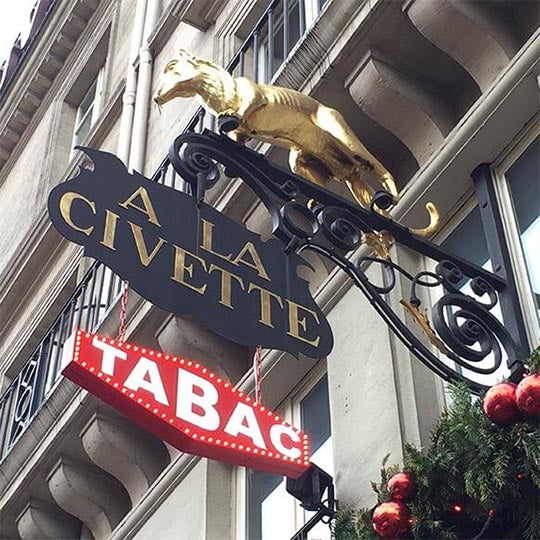
À La Civette
Share
Tabatière A La Civette is a well-known tobacco shop located in Paris, France. It is located at 157 Rue Saint-Honoré, in the 1st arrondissement of the city. It is a historic snuff shop known for its quality and was established in the 18th century. The shop has a long-standing history and is renowned for its association with tobacco and snuff products. It became a popular gathering place for connoisseurs of snuff, attracting notable clientele from various social classes.

A La Civette offered a wide selection of high-quality snuff blends and accessories, catering to the preferences of its diverse clientele. The shop's reputation extended beyond its products, as it also served as a meeting point for intellectuals, artists, politicians, and individuals interested in discussions on current affairs, literature, and the arts.
The shop's elegant and inviting ambiance, along with its knowledgeable staff, contributed to its popularity and patronage. "A La Civette" remains an iconic establishment in Paris, continuing its tradition of providing tobacco-related products and preserving the historical legacy of snuff culture.
Its seven letters are used to adorn the facade of most of our tobacconists, without however maintaining any link with the vulgar name of the species of garlic decorating our dishes, better known under the name of "chives ". From its appearance in France in the 16th century, the word “civet” designates a carnivorous mammal from Africa and India with a gray coat, dotted with black spots, whose smell it secretes was very popular.
Borrowed from the Italian "zibetto", itself derived from the Arabic "zabad", meaning "foam", "musk", specifies the French Academy, it is of perfume that it is a question when this term is used. Because the “civet” qualifies, by extension, the liquid extracted from the strongly musky substance, secreted by the glands of the animal. After dilution, there was a time when the scent obtained was widely used in perfumery.

In 1863, in Le Capitaine Fracasse, Théophile Gautier wrote: “The smell of smoky candles is worth more to me than civet, benzoin and ambergris.” Although for the sake of respect for animal life, this natural fragrance is now replaced by synthetic extracts, the word "civet" has not disappeared from our vocabulary.
As the English chemist Septimus Piesse explains in Histoire des Parfums et Hygiene de la Toilette, in 1905, during the heyday of snuff, the "civet", like the Tonka bean, was used to flavor molasses tobacco, dried and then reduced to powder before being consumed.
It was then that in 1716, near what was the Palais Cardinal, not far from the Palais du Louvre, one of the holders of this bar named his establishment À la Civette. Located opposite the Café de la Régence, a renowned place where the best chess players and flavored tobacco lovers competed, the brand became just as famous. And for good reason, according to the institution sitting rue Saint-Honoré since 1854, the young Duchess of Chartres, wife of Louis-Philippe d'Orléans, reportedly declared in 1754 that "the best tobacco in Paris" was sold there.
Its reputation was such that many Parisian and provincial traders would have liked to take advantage of this notoriety by naming their establishment in the same way. Also, in L’Assommoir in 1877, Émile Zola mentioned the Little Civet of the rue des Poissonniers.
